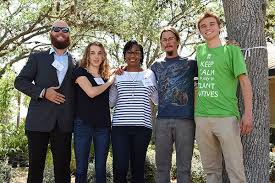Benefits of Landscaping with Keystone Native Trees
To put it plainly, incorporating native trees into your landscape is easy! You just need to pick the appropriate tree for the space (right plant, right place… right?). So then why aren’t we planting more trees in our yards? We all know trees are good for the environment, and that deforestation is bad. Still, trees don’t have the best reputation because people are under the impression that they are messy, that high winds will cause tree failure which can damage property, that they bring “pests” to your yard, that they are more expensive to prune, and the list goes on and on. I’d like to bring another perspective to the table and explain a few reasons why trees should be reconsidered, and why our landscapes should actually be focused around more trees.
Trees are not only our largest plants and largest group of larval host plants, but many trees are also keystone species in our Florida ecosystems. What is a keystone species and why is it important? A keystone plant species is a plant that supports the life cycle of many species. Without these keystone species, the life cycles collapse, which collapses the ecosystem. In other words, without these species present, we enter a waste land, void of life and full of struggles. According to Entomologist Dr. Doug Tallemey, keystone species are represented by 14% of plant life which supports 90% of all moth and butterfly species. They also support enough life that 96% of terrestrial birds rely on these species. There is a long list of why birds are important for humans: natural pest control (insects and rodents), disperse native seeds and beneficial fungus, their poop fertilizes soils, pollinate, and provide us humans beauty and happiness. Basically we need them more than they need us.
Like I mentioned earlier, trees can get a bad rap, especially in Florida. A lot of that has to do with the hurricanes we experience. But what most people don’t realize is that trees actually slow hurricane winds. Why have so many recent hurricanes sustained high winds for so long into the interior of our state and sometimes all the way across? One reason is because there is less to slow the wind other than fragmented forests and all of the many increasing buildings popping up statewide. Buildings, however, are nowhere near as efficient at slowing down winds as trees. Trees are our best chance of diminishing hurricane winds, but we need more than just one tree all by itself. We need many trees so they can support each other and keep us safer. We must connect the fragments.
Another big myth about trees is that oak trees specifically should be cut down to keep them from falling on your house during a hurricane or high winds. Of course, if the tree is diseased or declining, it’s best to take it down. But instead of cutting down healthy trees, after everything we just learned in the above paragraph about trees and hurricanes, why don’t we plant MORE? Think of it as creating a wall or moat around your home. One tree by itself isn’t a great defense, similar to any sports team, military, or business. It takes many working together to achieve the best results. A property with groups of trees, in which their canopies overlap, will work together to slow winds and support each other, strengthening their ability to hold up in high wind events.This is good for your property as it reduces the localized wind it will be exposed to which decreases the risk of property damage.
Of course there are MORE great reasons to have trees in Florida other than just to help slow down powerful winds. To name a few:
- SHADE is a big reason. As temperatures rise, we could all use a little more shade where temperatures can be twenty degrees cooler than in the sun. That’s a significant difference!
- Property values increase in neighborhoods with trees! Have you ever noticed that the wealthiest neighborhoods have the most trees? People are more likely to buy a house with trees than without!
- Erosion and flooding is reduced by trees! Trees slow rainfall, hold soil together, and evenly disperse water.
Hopefully by now you’re convinced by at least one of these great reasons to plant more trees in your landscape. What if we considered at least a couple of these reasons and selected a few of our native keystone species that support hundreds, or even thousands of life cycles that we as humans rely on, and plant them around our homes? There are many different sizes of trees that can fit any size landscape, even the less spacious ones. If we construct our environment with these keystone species and build our natural, living walls house by house, we can create a community of trees and an ecosystem bustling with life!
So in conclusion, yes, trees can be messy when they drop their sticks and leaves. If planted too close to infrastructure they can cause some damage. However, the benefits of having trees heavily outweigh these minor issues that are often misconceptions when utilizing a right plant, right place strategy. Our mindset must change in order to protect our state. If we can adopt a “plant more trees” rather than “remove more trees” mindset, we have a better chance of experiencing less environmental hardships in the future. We MUST learn to live with nature and not on it. We must help our trees stand tall with support of more trees and connect our fragmented environments to protect the future of the land we live IN, not ON.

